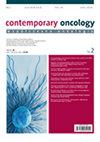有氧训练对绝经前乳腺癌内分泌治疗妇女身体成分的影响
IF 2.9
Q2 ONCOLOGY
引用次数: 0
摘要
本研究旨在确定乳腺癌患者内分泌治疗后体成分(BC)的变化,并探讨有氧训练对这些参数的影响。材料与方法:41例32-48岁乳腺癌内分泌治疗(ET)患者(平均±SD 44.1±4.4)。这是一项非随机的前瞻性试验。按照时间表对患者进行以下检查:1、ET开始前;II . ET 6个月后;经过12个月的ET和6个月的有氧训练。采用双x线吸收仪(DEXA)评估身体成分,包括游离脂肪量、瘦肉量、脂肪量以及android和gynoid脂肪的百分比位置。根据身高、体重和选定的人体测量参数BMI和WHR来评估体格。结果:在未进行常规身体活动的ET前6个月,报告如下:体重,BMI,脂肪组织数量,包括android脂肪分布显著增加(p 0.05)。当时肌肉减少(p 0.05)。在6个月的有氧运动后,没有观察到明显的体重或BMI增加。大鼠腰宽比显著降低(p < 0.05),且与脂肪组织减少相关(p < 0.05)。在DEXA中评估的其他元素在统计上没有显著变化。结论:结果分析使我们得出结论,在乳腺癌ET期间,据报道患者的BC和体格发生了负面变化。因此,建议该患者群体定期接受康复治疗,以减少治疗的副作用。然而,有氧训练似乎不足以完全减少这种癌症治疗形式的副作用。本文章由计算机程序翻译,如有差异,请以英文原文为准。
The influence of aerobic training on body composition in premenopausal women undergoing endocrine therapy for breast cancer
study was to determine the body composition (BC) changes in women with breast cancer after endocrine therapy, and the influence of aerobic training on the parameters under discussion. Material and methods: 41 women aged 32-48 (mean ± SD 44.1 ±4.4) with breast cancer during endocrine therapy (ET). This was a nonrandomized, prospective trial. The following examinations were conducted in patients according to the schedule: I before the beginning of ET; II after 6 months of the ET; III after 12 months of ET and after 6-month aerobic training. Body composition was evaluated using dual X-ray absorptiometry (DEXA) with respect to free fatty mass, lean, fat and the percentage location of android and gynoid fat. The body build was evaluated with respect to body height, body weight and selected anthropometric parameters BMI and WHR. Results: During the first six months of ET without regular physical activity the following was reported: a significant increase of body weight, BMI, the amount of fatty tissue, including android fat distribution (p 0.05). At that time muscle (p 0.05) reductions were reported. After the sixmonth aerobic workout no significant body weight or BMI increase was observed. However, there was a significant reduction in WHR (p < 0.05), which correlated with the decrease of android fatty tissue (p < 0.05). The other elements evaluated in the DEXA underwent statistically insignificant changes. Conclusions: The outcome analysis allows us to conclude that during breast cancer ET the patients are reported to have negative changes in BC and phy sique. Therefore, this patient group is advised to receive regular rehabilitation with the aim of reducing the side effects of the treatment. However, aerobic training seems to be insufficient in order to fully reduce the side effects of this form of cancer therapy.
求助全文
通过发布文献求助,成功后即可免费获取论文全文。
去求助
来源期刊
CiteScore
3.10
自引率
0.00%
发文量
22
审稿时长
4-8 weeks
期刊介绍:
Contemporary Oncology is a journal aimed at oncologists, oncological surgeons, hematologists, radiologists, pathologists, radiotherapists, palliative care specialists, psychologists, nutritionists, and representatives of any other professions, whose interests are related to cancer. Manuscripts devoted to basic research in the field of oncology are also welcomed.

 求助内容:
求助内容: 应助结果提醒方式:
应助结果提醒方式:


